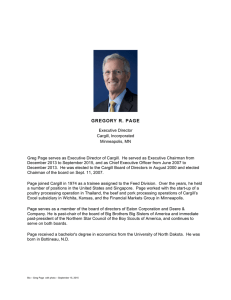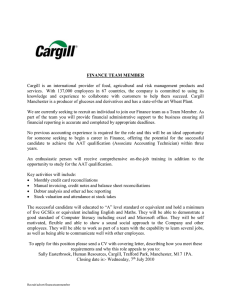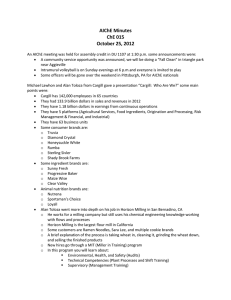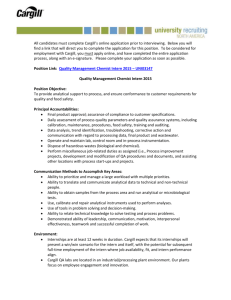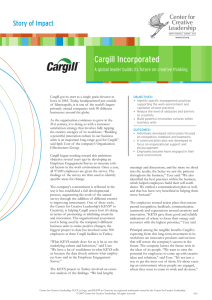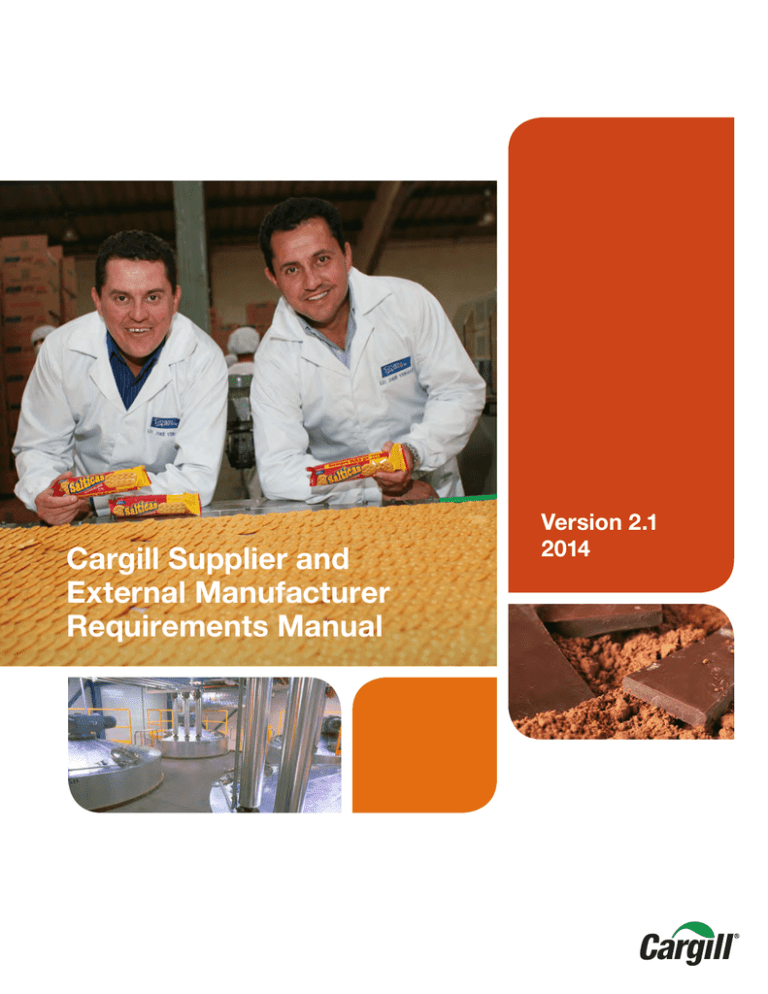
Cargill Supplier and
External Manufacturer
Requirements Manual
Version 2.1
2014
NOTE TO OUR SUPPLIERS AND
EXTERNAL MANUFACTURERS
I am pleased to introduce Cargill’s latest Supplier
and External Manufacturer Management Manual.
Cargill is committed to providing healthy, nutritional
food/feed products and services throughout our
supply chain. We will use only those product
development, procurement, supply chain,
transportation, storage, production, manufacturing,
and distribution systems and suppliers that ensure
the safety and regulatory compliance of our
products. Every Cargill Business Unit, Function,
and employee has a responsibility to ensure the
production of safe products that comply with the
applicable laws, regulations and Corporate Food
Safety, Quality and Regulatory requirements.
Cargill management will provide the resources and
support necessary to enable our employees to
fulfill this responsibility.
Through our efforts with you, our suppliers and
external manufacturers, we will continue to work
to mitigate food/feed safety risks, reduce quality
risks, and keep people and animals safe. On behalf
of Cargill, I want to thank you for your continuing
hard work.
Sincerely,
Mike Robach
VP, Corporate Food Safety, Quality and Regulatory
Cargill, Incorporated
CONTENTS
Introduction
1
I. Requirements for ingredients
suppliers, bio-chemical suppliers
and external manufacturers
3
II. Requirements for food/feed
contact packaging suppliers
5
III. Requirements for for food/feed
contact chemical and processing
aid suppliers
7
IV. Qualification of all types
of suppliers and external
manufacturers
8
V. Management of all types
of suppliers and external
manufacturers
11
VI.Variances
12
VII. Glossary of terms
13
CARGILL SUPPLIER AND EXTERNAL MANUFACTURER REQUIREMENTS MANUAL, VERSION 2.1 2014
Introduction
Cargill provides food, agriculture, financial and industrial
products and services to the world. Together with farmers,
customers, governments and communities, we help people
thrive by applying our insights and nearly 150 years of
experience. We have 143,000 employees in 67 countries
who are committed to feeding the world in a responsible
way, reducing environmental impact and improving
the communities where we live and work. In light of its
geographic, cultural, economic, and regulatory diversity and
mission, Cargill has set global food and feed safety, quality
and regulatory processes and standards to ensure the
consistency and integrity of all of our products and services.
Cargill’s mission and food/feed safety policy reflect a core
value for Cargill – nourishing people and ensuring that our
food and feed products keep people and animals safe. We
have complex supply chains, a global footprint that requires
full cooperation and support from our suppliers and external
manufacturers (S/EMs), and customers focused on food/
feed safety that expect us to do the same with our S/EMs.
This requires Cargill to ensure our S/EMs are aligned with our
values and operate in full compliance with Cargill’s food/feed
safety, quality and regulatory requirements.
In 2011, Cargill began deploying one global consistent
process for qualifying suppliers and external manufacturers.
It is called the Supplier and External Manufacturer
Management Process or S/EM Process. A major goal of
the process is to enable Cargill to qualify suppliers that
are capable of meeting all the requirements of our many
business units and reduce redundant requalification by
multiple businesses. The current scope of the S/EM Process
is food/feed ingredients, food/feed processing aids, food/
feed contact chemicals, food/feed contact packaging
and all materials produced on behalf of Cargill by External
Manufacturers.
We recognize that processing aids, contact chemicals and
contact packaging may not be subject to the same legal
and regulatory and global food/feed safety standards as
materials consider by Cargill as food/feed ingredients, but
these suppliers are still expected to have processes in place
to ensure the purity of their production, control contamination
risks, manage changes and meet specifications. Specific
requirements for processing aids, contact chemicals and
contact packaging suppliers are included in this manual.
However it is Cargill’s stance that all suppliers should
understand the requirements of ingredients suppliers,
so that they can better understand our food/feed safety
culture. Suppliers of non- ingredient materials who choose
to apply food/feed safety standards and best practices to
their processes reduce Cargill’s overall food/feed safety
risk. It is Cargill’s desire to partner with S/EMs to share best
practices in the areas of food/feed safety, quality, regulatory
compliance and continuous improvement.
This manual is designed for use by our S/EMs and provides
information on (i) Cargill’s food/feed safety, quality and
regulatory compliance requirements for S/EMs (the “Cargill
S/EM Food Safety Requirements”) and (ii) Cargill’s food
safety, quality and regulatory compliance qualification
and management processes for S/EMs (“Cargill’s S/EM
Qualification and Management Processes”).
1
2
CARGILL SUPPLIER AND EXTERNAL MANUFACTURER REQUIREMENTS MANUAL, VERSION 2.1 2014
I. Requirements for ingredients suppliers, bio-chemical
suppliers and external manufacturers
There are three basic components to Cargill’s Food/Feed
Safety, Quality and Regulatory Requirements: (i) Legal and
Regulatory Requirements, (ii) Pre-requisite Programs and
HACCP Requirements and (iii) Cargill Specific Requirements.
There are also a few additional requirements for External
Manufacturers.
A. LEGAL AND REGULATORY REQUIREMENTS
Cargill requires S/EMs to establish their food/feed safety
programs to fully comply with all applicable legal and
regulatory requirements. It is each S/EMs obligation to
determine, understand and comply with the legal and
regulatory requirements that apply to their operations and
products both in the country of manufacture and the country
of delivery of services and products. If Cargill requires
any S/EM to comply with the laws and regulations of any
other jurisdiction, Cargill will communicate those additional
requirements to the affected manufacturer S/EMs.
B. PRE-REQUISITE PROGRAMS AND HACCP
REQUIREMENTS
Cargill also requires that Suppliers and External Manufacturers
to our human and pet food businesses comply with Codex,
the international standard for food safety programs,
RECOMMENDED INTERNATIONAL CODE OF PRACTICE
GENERAL PRINCIPLES OF FOOD HYGIENE CAC/RCP
1-1969, Rev. 4-2003 1 http://www.codexalimentarius.org.
Suppliers to our animal food/feed businesses must comply
with PAS 222, PAS 222:2011 PREREQUISITE PROGRAMMES
FOR FOOD SAFETY IN THE MANUFACTURING OF FOOD
AND FEED FOR ANIMALS http://shop.bsigroup.com/en/
forms/PASs/PAS-222/.
External Manufacturers to our animal food/feed business must
comply with ISO 22000 and PAS 222, ISO 22000:2005 FOOD
SAFETY MANAGEMENT SYSTEMS – REQUIREMENTS FOR
ANY ORGANIZATION IN THE FOOD CHAIN http://www.iso.
org/iso/home/standards/management-standards/iso22000.
htm and PAS 222:2011 PREREQUISITE PROGRAMMES FOR
FOOD SAFETY IN THE MANUFACTURING OF FOOD AND
FEED FOR ANIMALS http://shop.bsigroup.com/en/forms/
PASs/PAS-222/.
C. CARGILL SPECIFIC REQUIREMENTS
In addition to meeting Legal and Regulatory Requirements
and implementation of Pre-requisite Programs and HACCP
Requirements, Cargill has identified several additional
requirements which S/EMs must also meet.
1. Product, Material or Service Specific Requirements: For
some products, materials and services, Cargill and Cargill
customers have additional requirements. If so, these
additional requirements will be separately identified to the
S/EM. Examples of this are: identity preservation, nonGMO, Kosher, feed nutritional value requirements as well
as others.
2. Management Systems: A management system identifies
and institutes control of food/feed safety hazards,
communicates internally and externally regarding food/
feed safety and ensures continual improvement of the
food/feed safety system. Examples include a clearly
stated food/feed safety policy, management review and
verification of the system, dedicated resources for food/
feed safety, quality and regulatory management, and food/
feed safety training for employees.
3. Internally managed audit system: Systems to complete
internal audits of their own facilities, as well as systems for
monitoring completion of corrective action findings.
4. Product Defense: Having measures in place to reduce the
chances of intentional contamination of the human food/
animal food/feed supply. Also known as human food/
animal food (feed) defense or human food/animal food
(feed) security.
3
5. Food/Feed Grade Inputs: S/EMs must use only food grade 10. Line of Sight: S/EMs must develop a system for the
inputs or inputs approved for food use in the manufacture
identification of the supply chain for each of their
of products or materials or the provision of services to
products. An example of this might be: An S/EM
Cargill. Food Grade inputs satisfy the pertinent Food
purchases a material from a broker who sources their
Chemical Codex (FCC) standard/specification or some
material from multiple sources and countries. The S/EM
other globally-recognized food standard/specification,
must understand what these sources are as well as what
are produced under the appropriate prerequisite
geographies the material came from in order to provide a
programs, and comply with any regulatory requirements
line of sight when there is a food/feed safety incident.
for food grade for that particular substance in relevant
11. Key Process Indicators: may be required for S/EMs.
geographies. Exceptions require the approval of Cargill.
Feed Grade or Food Grade Inputs may be used for animal 12. Required Documents: S/EMs will be required to provide
feed materials, provided they meet globally recognized
specific documents to Cargill for qualification and those
feed standards and specifications.
documents will be required to be updated periodically.
When an updated document is requested, suppliers must
6. Food Allergen Control: Systems must exist for the control
ensure the document is internally reviewed and newly
and prevention of incidental co-mingling of food allergens
dated. Cargill stores food/feed safety related documents
and to ensure proper labeling of allergens in products (not
for no longer than three years and this applies to S/EM
required for animal food/feed).
documents as well. Generally, S/EMs will be requested to
7. Food/Feed Safety Product Testing (including testing for
provide annual updates to documents unless otherwise
Adulterants): Product that is tested for any biological,
specified.
chemical or physical hazard that may render a food or
13. Global Food Safety Initiative (GFSI) benchmarked scheme
feed product unfit for its intended use may not be shipped
certification for human food or an agreed upon plan with
until testing is complete and product is determined safe.
Cargill to achieve certification.
This definition applies to hazards that are naturallyoccurring, occur through a processing error, or are
14. Allow Cargill to complete a targeted visit to the
intentionally added to do harm.
manufacturing site to better understand risk associated
8. Good Laboratory Practices: Systems must be in place
to ensure reliability of laboratory results for testing done
on products or materials manufactured for Cargill. This
includes use of recognized test methods, documented
procedures, trained and competent technicians, calibrated
and maintained equipment.
9. Supplier Qualification Program: S/EMs must have
in place preventative measures for food/feed safety,
regulatory compliance, food/feed defense, and quality
management programs for their suppliers. Prevention
requires that these features be integrated into the S/EMs
procurement processes and requires close interaction
with growers, suppliers, manufacturers, distributors,
service providers, and importers. All S/EMs must have
approval and monitoring programs for their own suppliers
which programs, at a minimum, consist of a combination
of appropriate programs, specifications, policies and
procedures described in this document.
4
with the site and products manufactured there.
D. ADDITIONAL REQUIREMENTS FOR EXTERNAL
MANUFACTURERS
1. External Manufacturers will be required to complete
Packaging Graphics Approval with Cargill prior to
manufacturing any product and must not change the
packaging without prior approval from Cargill.
2. Master Manufacturing Records may be created with each
External Manufacturer.
3. Key Process Indicators will likely be developed with each
External Manufacturer.
4. Technical and process capabilities may be assessed and
improvement programs required.
5. Internationally recognized feed safety and quality
certification for external manufacturers of animal food/
feed.
CARGILL SUPPLIER AND EXTERNAL MANUFACTURER REQUIREMENTS MANUAL, VERSION 2.1 2014
II. Requirements for Food/Feed Contact Packaging Suppliers
A. LEGAL AND REGULATORY REQUIREMENTS
1. Suppliers must ensure their products are compliant with
both their local food/feed contact packaging material
regulations for the intended use of the material as well as
those of the intended recipient country.
2. Must be prepared to provide proof of compliance with
those regulations, including, but not limited to, migration
and/or leach-ability testing results with the materials that
are intended to be contained in the packaging.
B. PRE-REQUISITE PROGRAMS, FOOD/FEED SAFETY
AND QUALITY REQUIREMENTS
1. Their processing plants and systems meet the Publicly
Available Standard (PAS) 223:2011 Prerequiste
programmes and design requirements for food safety
in the manufacture and provision of food packaging
from the British Standards Institute. This eventually
will become an ISO Technical Standard (ISO-TS
xxx) (http://shop.bsigroup.com/en/ProductDetail/
?pid=000000000030240355 – note PAS must be
purchased.)
2. Have completed and documented hazard assessment of
their process, incoming materials and finished product
6. Their quality management process includes a process for
assessing compliance to specifications.
C. CARGILL SPECIFIC REQUIREMENTS
1. To assess our supplier’s ability to meet the above
requirements, Cargill will first administer a “Food Safety”
questionnaire. The response to this questionnaire
determines what the next steps or due diligence are for
Cargill to determine a supplier’s ability to demonstrate
compliance to the above guidelines. These next steps
may be:
• Provide Cargill with results from a Global Food Safety
Initiative (GFSI) benchmarked scheme audit that
aligns to PAS 223:2011, including corrective action
documentation.
• Provide Cargill with results from a third party audit that
aligns to PAS 223:2011, including corrective action
documentation.
• Allow Cargill to complete a food safety audit to better
understand risk associated with the site and products
manufactured there.
• Allow Cargill to complete a targeted visit to the
manufacturing site to better understand risk associated
with the site and products manufactured there.
3. Their processes ensure purity of product by preventing
and/or controlling contamination risks.
4. Their processes ensure that the packaging material
intended to come into contact with food must
be sufficiently inert to preclude substances from
being transferred to food in quantities large enough
to endanger human health or to bring about an
unacceptable change in the composition of the food or a
deterioration in it’s organoleptic properties.
5. Their quality management processes includes a process
for management of change, which includes customer
notification.
5
6
CARGILL SUPPLIER AND EXTERNAL MANUFACTURER REQUIREMENTS MANUAL, VERSION 2.1 2014
III. Requirements for Food/Feed Contact Chemical and
Processing Aid Suppliers
A. LEGAL AND REGULATORY REQUIREMENTS
C. CARGILL SPECIFIC REQUIREMENTS
1. Their products are compliant with both their local
regulations for the intended use of the material as well as
those of the intended recipient country.
1. To assess our supplier’s ability to meet the above
requirements, Cargill will first administer a questionnaire
to evaluate systems for managing quality and purity of
materials produced by the chemical supplier, as well as
any systems in place for managing food safety concerns.
The response to this questionnaire determines what the
next steps or due diligence are for Cargill to determine a
supplier’s ability to demonstrate compliance to the above
GMP guidelines as well as quality and purity of materials.
B. PRE-REQUISITE PROGRAMS, FOOD/FEED SAFETY
AND QUALITY REQUIREMENTS
1. Products are compliant with the Food Chemical Codex
(FCC) monograph http://www.usp.org/food-ingredients/
food-chemicals-codex
a. In cases where a product is not designed to meet this
standard an agreed upon specification must be in
place between Cargill and the supplier.
2. Processing plants meet the FCC General Good
Manufacturing Practices (GMP) Guidelines for Food
Chemicals http://www.usp.org/food-ingredients/foodchemicals-codex or International Food Additives Council
Good Manufacturing Practice and Quality Assurance
Guide for Food Additives and GRAS substances http://
www.foodadditives.org/foodsafety.html. (Note to access
the requirements at the above links, a subscription or
membership may be required.)
3. Processes ensure purity of product by preventing and/or
controlling contamination risks.
4. Articulate contamination risks for their process and
product
5. Their quality management processes includes a process
for management of change, which includes customer
notification.
2. These next steps may be:
• Provide Cargill with audit summary and corrective
action report from an ISO 9001 certification audit.
• If the material provided is covered in the Global Food
Safety Initiative (GFSI) Supply Chain Scope (i.e.
enzymes) see Part III Scheme and Scope Elements at
following link: http://mygfsi.com/technical-resources/
guidance-document.html, then provide Cargill with
results from a Global Food Safety Initiative (GFSI)
benchmarked scheme audit, including corrective action
documentation.
• If the material provided is not covered in the GFSI
Supply Chain Scope, then provide Cargill with results
from a third party GMP audit, including corrective
action documentation or an appropriate third party
audit that demonstrates supplier’s ability to conform
to requirements and maintain material purity, manage
quality processes and ensure customer satisfaction.
• Allow Cargill to complete a food safety audit to better
understand risk associated with the site and products
manufactured there.
6. Quality management process includes a process for
assessing compliance to specifications.
7
IV. Qualification of all types of Suppliers and External Manufacturers
Cargill’s initial qualification of S/EMs has four basic
components: (i) initial information and document request,
audit and/or verification, (ii) pre-qualification corrective action
plans, (iii) determination and communication of food/feed
safety status and (iv) plant trials.
A. INITIAL INFORMATION, DOCUMENT REQUEST, AUDIT
AND/OR VERIFICATION
Each prospective S/EM must undergo a food/feed safety,
quality and/or regulatory compliance review. Use of
questionnaires, S/EM documentation, inspection surveys,
3rd party food/feed safety audits and/or certifications (GFSI
preferred or internationally recognized feed safety and
internationally recognized quality certification, i.e. ISO 9001
for chemical suppliers) , Cargill audits, product testing, and
review of specification conformance capability are some of
the methods that Cargill may utilize to ensure our S/EMs
are able to consistently meet the Cargill Food/Feed Safety
Requirements.
B. PRE-QUALIFICATION CORRECTIVE ACTION PLANS
If Cargill identifies any failure to comply with Cargill’s Food/
Feed Safety Requirements in the initial audit and verification
phase, the S/EM must develop a proposed Corrective Action
Plan, including timelines for approval by Cargill. Supplier/
External Manufacturer is required to respond in two weeks
after receiving the audit with their corrective action plan for
any findings with timeline for implementation. Cargill will not
approve any Corrective Action Plan that does not result in
all Major Non-conformance(s) being corrected within two
months and all Minor Non-conformance(s) being corrected
within six months. However, Cargill may require that any
Non-conformance be corrected in a shorter period of time.
8
CARGILL SUPPLIER AND EXTERNAL MANUFACTURER REQUIREMENTS MANUAL, VERSION 2.1 2014
C. DETERMINATION AND COMMUNICATION OF INITIAL
S/EM FOOD/FEED SAFETY STATUS
Cargill will determine and communicate the initial Food/
Feed Safety Status of an S/EM following completion of
the initial audit and verification phase and, as appropriate,
development and/or implementation of a Corrective Action
Plan. Food/Feed Safety Status will be specific to S/EM
product(s)/material(s)/service(s), production line(s), and/or
plant(s). Note: this determination is of FOOD/FEED SAFETY
STATUS ONLY. It does not guarantee the S/EM has actually
been or will be awarded business with Cargill. Cargill’s
Food/Feed Safety Status classifications are: (i) Approved,
(ii) Approved with Conditions, (iii) Not Approved and (iv)
Disqualified. Use of an S/EM by Cargill will be limited to
those that have an acceptable Food/Feed Safety Status for
product(s)/material(s)/service(s), production line(s), and/or
plant(s).
The descriptions of Cargill’s Food/Feed Safety Status
classifications follow:
Approved: Cargill may use an S/EM who is in “Approved”
status. Any Non-conformances must be addressed by a
Corrective Action Plan approved by Cargill with verification
of completion of corrective action at next planned audit
and verification. In the interim, the S/EM must provide
documentation of successful implementation of the
Corrective Action Plan.
Approved with Conditions: Cargill will not use an S/EM
who is in “Approved with Conditions” status until: (i) the S/
EM has developed and implemented a Corrective Action
Plan approved by Cargill and (ii) Cargill has verified, to its
satisfaction, successful completion of the Corrective Action
Plan. Not meeting a Correction Action Plan deadline or failing
to provide satisfactory evidence of successful completion to
corrective action automatically results in an S/EM moving to
“Not Approved” status.
Not Approved: Cargill will not use an S/EM who is in “Not
Approved” status. An S/EM who is in “Not Approved” status
and desires to become “Approved” must develop and
implement a Corrective Action Plan, approved by Cargill, and
Cargill must verify successful completion of the Corrective
Action Plan and compliance with Cargill’s Food/Feed Safety
Requirements through a re-audit.
Disqualified: Cargill will not use an S/EM who is in
“Disqualified” status. Disqualified status reflects that an S/
EM has severe gaps in its food/feed safety programs. S/EMs
who are assigned “Disqualified” status are not allowed to
re-apply to supply Cargill for at least one year from the date
they are assigned this status and, if they re-apply to supply
Cargill, will be required to go through Cargill’s most stringent
verification process.
D. PLANT TRIALS
If an S/EM is required to complete a plant trial, this
requirement will be communicated to the S/EM during the
qualification process. A plant trial may not occur in a Cargill
or an S/EM facility until the S/EM has been assigned an
acceptable Food/Feed Safety Status. The results of a plant
trial may or may not change an S/EMs Food/Feed Safety
Status.
9
10
CARGILL SUPPLIER AND EXTERNAL MANUFACTURER REQUIREMENTS MANUAL, VERSION 2.1 2014
V. Management of all types of Suppliers and External
Manufacturers
Cargill’s ongoing management of S/EMs has five main
components: (i) periodic audit and/or verification of
compliance, (ii) ongoing monitoring, (iii) triggering event
management, (iv) post-qualification Corrective Action Plans
and (v) Updates to Food/Feed Safety Status.
A. PERIODIC AUDIT AND/OR VERIFICATION OF
COMPLIANCE
Each S/EM must permit Cargill and its designees (including
third party auditors and customers), upon reasonable
advance notice, to audit and inspect the facilities used to
manufacture Product or Material for Cargill and/or provide
Services to Cargill. S/EMs must also permit Cargill to review
records and obtain retained samples pertaining to that
Product, Material or Service.
B. MONITORING PERFORMANCE
As part of its S/EM program, Cargill will also monitor S/EMs
ongoing performance through various means. Cargill will
advise each S/EM of those documents and other information
it will require for its monitoring from the S/EM. The
required documents could change periodically. Monitoring
requirements may change from time to time depending on
an S/EMs Food/Feed Safety Status, performance, regulatory
changes and other factors. Some examples of the type of
documentation and other information that may be required
are listed below:
• Product Data (e.g., protein, fat, fiber, ash, MDF, moisture,
particle size)
• Microbiological testing results
• Contamination testing results
• Monthly reports on Key Performance Indicators
• Third Party Audits
• Product Material Safety Data Sheet
• Complaints and Requests for Reimbursements
• Management of Change records
• Batch records
• Process Control Chart (Target / Range)
C. TRIGGERING EVENT MANAGEMENT
A “Triggering Event” is an event or circumstance that might
cause Cargill to change the Food/Feed Safety Status or
another component of its management of one or more S/
EMs. A change to the Food/Feed Safety Status of an S/EM
or another component of Cargill’s management of an S/EMs
may be positive or negative. Examples of triggering events
include, but are not limited to, the following:
• Product Retrieval Incidents – e.g., Recall, Withdrawal
• Plant, Ingredient or Process Change at the S/EM or Cargill
• Specification Change by S/EM or Cargill
• Industry/Economic/Media Events – e.g., melamine
• Change in Regulations or Regulatory Enforcement
• Trends in Key Performance Indicators
• Breach of Supplier Code of Conduct
• Audit Results
• Ownership or Financial Change
D. POST-QUALIFICATION CORRECTIVE ACTION PLANS
If Cargill identifies any failure to comply with Cargill’s Food/
Feed Safety Requirements as a result of a periodic audit and/
or verification, ongoing monitoring or a triggering event, the
S/EM must promptly develop a proposed Corrective Action
Plan, including timelines for approval by Cargill. Cargill will
not approve any Corrective Action Plan that does not result
in all Major Non-conformance(s) being corrected within two
months and all Minor Non-conformance(s) being corrected
within six months. However, Cargill may require that any
Non-conformance be corrected in a shorter period of time.
E. UPDATES TO FOOD/FEED SAFETY STATUS
If the results of a periodic audit and/or verification, ongoing
monitoring or a triggering event investigation reflect
that an S/EM is not meeting Cargill’s Food/Feed Safety
Requirements, Cargill has the right to change an S/EMs
Food/Feed Safety Status. If the S/EMs Food/Feed Safety
Status changes from Approved or Approved with Conditions
11
to Not Approved or Disqualified, Cargill has the right to
immediately terminate use of the S/EM and its contract with
the S/EM with no liability. If, for any reason, it is appropriate to
change the S/EM designation, Cargill will promptly notify S/EM
of that change.
F. MANAGEMENT OF CHANGE
S/EMs must not change the specification, production process,
inputs or material without prior notice to and approval by
Cargill. Changes such as these can result in significant changes
within Cargill’s processes, potentially introducing new food/
feed safety issues and will require thorough testing and review
prior to acceptance. Cargill should also be notified when S/EMs
change legal names or ownership as this may affect our internal
documents or documents linked to regulatory requirements.
VI. Variances
In rare cases, Cargill may permit S/EMs to deviate from one or
more of the Cargill Food/Feed Safety Requirements set forth in
this manual. Any such deviation must be approved by Cargill, in
writing.
12
CARGILL SUPPLIER AND EXTERNAL MANUFACTURER REQUIREMENTS MANUAL, VERSION 2.1 2014
VII. Glossary of Terms
Ingredient
Those materials that directly contact and are part of the
mixture of the finished product. The material is usually
declared or stated on the label of the finished product as
required by government regulations. Examples: parsley,
soybean oil, cocoa powder, sucrose, ground beef,
glucosamine, sugar, eggs, whey, buttermilk, minerals, amino
acids, enzymes.
Processing Aid
Substance(s) added to a human/animal food during its
processing and which are removed, consumed by the
process, or reduced in some manner before food is
packaged in finished form. The substance may or may not
be declared on a label depending upon labeling requirements
and government regulations.
Food/Feed Contact Chemical
Substances that are directly added to a human/animal
food/feed product during processing and converted to a
constituent normally present in the finished product. Can also
have a direct functional purpose. Frequently referred to as a
chemical or chemical compound.
Food/Feed Contact Packaging
Packaging material which directly contacts or touches food/
feed.
HACCP
Hazard Analysis and Critical Control Point (HACCP) is a
system that identifies, evaluates and controls hazards which
are significant for food/feed safety.
GFSI
Global Food Safety Initiative (GFSI) is collaboration between
some of the world’s leading food/feed safety experts.
GFSI Benchmark Scheme Certification
The GFSI Program provides a framework for a system of
independent certification that a supplier’s food/feed safety
and quality management system complies with international
and domestic food/feed safety regulations.
Cargill Food/Feed Safety Requirements
There are three basic components to Cargill’s Food/Feed
Safety, Quality and Regulatory Requirements:
• Legal and Regulatory Requirements
• Pre-requisite Programs and HACCP Requirements
• Cargill Specific Requirements
There are also a few additional requirements for External
Manufacturers.
Food/Feed Safety Status
Cargill’s Food/Feed Safety Status classifications are:
• Approved
• Approved with Conditions
• Not Approved
• Disqualified
Use of an S/EM by Cargill will be limited to those that have
an acceptable Food/Feed Safety Status for product(s),
material(s), service(s), production line(s), and/or plant(s).
Corrective Action Plan
Corrective Action is an action taken to eliminate the causes
of an existing non-conformity or other undesirable situation.
The plan is the set of action items and targeted completion
dates that surround corrective action.
S/EM
Supplier and External Manufacturer
• Supplier includes any provider of goods and services which
are used to produce Cargill products.
• An External Manufacturer (EM) is a non-Cargill facility
that “processes” and provides a “finished product” that
(i) is sold under a Cargill or customer brand and/or (ii) is
produced using a Cargill or customer specified process/
recipe/specifications. A vendor who supplies a finished
product to Cargill.
13
www.cargill.com
Corporate Food Safety, Quality & Regulatory
15615 McGinty Road West
Wayzata, MN 55391
© 2014 Cargill, Incorporated. All Rights Reserved.


